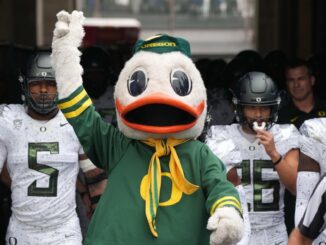
In a sport where narratives are built around quarterbacks, headlines highlight skill players, and rankings lean on reputation, the grunt work often gets lost in translation. But championship football is still won the old-fashioned way—at the line of scrimmage.
And in that space where schemes collide and physicality reigns, the Oregon Ducks may finally be building something that doesn’t just flash, but sustains. When Pro Football Focus released its early positional rankings ahead of the 2025 season, one line stood out: Oregon’s defensive line is among the best in the country.
Not just in the Big Ten. Nationally elite. For a program long known more for tempo than toughness, that recognition isn’t just validation—it’s recalibration.
From Flash to Force: The Ducks’ Rebrand in the Trenches
There was a time when Oregon football was synonymous with speed. Fast snaps. Fast receivers. Fast highlights. Under Chip Kelly and Mark Helfrich, the Ducks were one of college football’s great offensive spectacles. But in the biggest games—national championships, Rose Bowls—the Achilles’ heel was always the same: physicality.
Oregon could run around you. But not always through you.
Enter Dan Lanning. A disciple of Kirby Smart and Georgia’s fearsome 2021 defense, Lanning didn’t come to Eugene to replicate Oregon’s past. He came to reshape its future. And that mission started in the trenches.
Lanning brought SEC sensibilities to a West Coast roster. That meant bigger bodies, deeper rotations, and a fundamental shift in how Oregon recruits and develops talent—especially up front. It’s no longer about edge speed or splashy sacks. It’s about winning the line of scrimmage, snap after snap. The Ducks aren’t just trying to disrupt. They’re trying to dominate.
Meet the Monsters in the Middle
So, who’s powering this transformation?
- Derrick Harmon, a transfer from Michigan State, is the rock in the middle. He led all FBS interior defensive linemen with 55 pressures last season and earned second-team All-America honors.
- Bear Alexander, another high-profile transfer, brings SEC pedigree and violent disruption on the inside. His 2024 film at USC charted 74.3% backfield penetration and 90.9% positive plays.
- Matayo Uiagalelei, a sophomore, broke out last season and earned First-Team All-Big Ten honors. His length, explosiveness, and football IQ make him a matchup nightmare off the edge.
- A’Mauri Washington, a steady presence on the interior, continues to eat up space and command double-teams in short-yardage situations.
- Popo Aumavae, now in his sixth year, brings leadership and toughness. He’s a high-effort run-stopper who’s battled back from injury to anchor key snaps.
- Behind them are blue-chip prospects like Elijah Rushing and Tionne Gray, giving Oregon depth that rivals any in the country.
As a group, Oregon finished No. 13 nationally in pressure rate (37.5%) last season—without relying on blitzing. They also held opponents to just 98.3 rushing yards per game, good for No. 11 in the country.
Why PFF’s Recognition Hits Differently
Preseason hype is often just noise. But Pro Football Focus doesn’t trade in hype—they trade in tape. Every grade is rooted in film study, positional performance, and advanced metrics like pressure rate, run-stop win percentage, and gap integrity.
So when PFF singles out Oregon’s defensive front, it’s not just a compliment—it’s a benchmark. It confirms that the philosophical shift Lanning initiated is not just underway. It’s working.
Oregon’s 2024 defense showed improved efficiency, cleaner tackling, better gap discipline, and fewer explosive plays allowed. The Ducks don’t need to blitz to generate chaos anymore. They can win with four, and rotate with six.
That’s elite territory.
Beyond Rankings: Culture in the Trenches
Elite defensive lines don’t just reflect talent. They reflect culture.
You can’t fake physicality. You can’t rotate six deep unless the second unit is hungry. That’s what makes this so promising for Oregon. It suggests a culture where defensive linemen aren’t just eager to play—they want to dominate. They want to do the dirty work. The kind of reps that don’t show up on TikTok but do show up on 3rd-and-1.
More importantly, Oregon is now developing players, not just collecting them. That’s a big shift. The Ducks have always recruited speed and star ratings. But now they’re turning that talent into disciplined, versatile linemen who understand leverage, assignment football, and physical finishing.
What Comes Next?
The praise is nice. But this is the year Oregon must prove it’s not just a strong unit—it’s an identity.
In a 12-team playoff era, where depth and durability separate contenders from pretenders, Oregon’s ability to rotate quality linemen could be the difference between a strong season and a title run.
The Ducks don’t need to become Georgia overnight. But they do need to become a more physical version of themselves. They have the blueprint. They have the talent. And for the first time in a long time, they might just have the trench credibility to back it up.
Final Thoughts: Truth in the Trenches
We live in an era where flash dominates the discourse. But when it comes to building real contenders, the truth still lives in the trenches.
If Oregon’s defensive line continues on this trajectory, that truth is starting to sound a lot like dominance.
PFF won’t hand out trophies. But their praise confirms what Oregon fans have long hoped: beneath the uniform combos, the hype videos, and the offensive wizardry, the Ducks are evolving into something sturdier.
Because championships aren’t won in September. They’re won in the short-yardage battles. On cold nights. In loud stadiums. Against teams that expect to outmuscle you.
And maybe—just maybe—Oregon is finally ready to push back.



